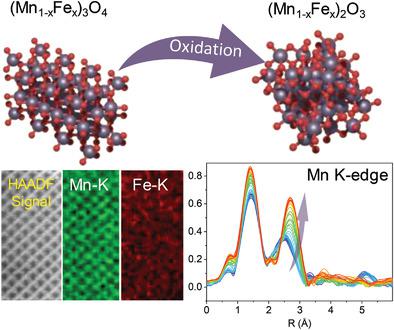当前位置:
X-MOL 学术
›
Small Methods
›
论文详情
Our official English website, www.x-mol.net, welcomes your
feedback! (Note: you will need to create a separate account there.)
Determining the Role of Fe-Doping on Promoting the Thermochemical Energy Storage Performance of (Mn1−xFex)3O4 Spinels
Small Methods ( IF 10.7 ) Pub Date : 2021-09-09 , DOI: 10.1002/smtd.202100550 Alfonso J Carrillo 1 , Lidia E Chinchilla 2 , Ana Iglesias-Juez 3 , Santiago Gutiérrez-Rubio 4 , Daniel Sastre 4 , Patricia Pizarro 4, 5 , Ana B Hungría 2 , Juan M Coronado 3
Small Methods ( IF 10.7 ) Pub Date : 2021-09-09 , DOI: 10.1002/smtd.202100550 Alfonso J Carrillo 1 , Lidia E Chinchilla 2 , Ana Iglesias-Juez 3 , Santiago Gutiérrez-Rubio 4 , Daniel Sastre 4 , Patricia Pizarro 4, 5 , Ana B Hungría 2 , Juan M Coronado 3
Affiliation

|
Mn oxides are promising materials for thermochemical heat store, but slow reoxidation of Mn3O4 to Mn2O3 limits efficiency. In contrast, (Mn1−xFex)3O4 oxides show an enhanced transformation rate, but fundamental understanding of the role played by Fe cations is lacking. Here, nanoscale characterization of Fe-doped Mn oxides is performed to elucidate how Fe incorporation influences solid-state transformations. X-ray diffraction reveals the presence of two distinct spinel phases, cubic jacobsite and tetragonal hausmannite for samples with more than 10% of Fe. Chemical mapping exposes wide variation of Fe content between grains, but an even distribution within crystallites. Due to the similarities of spinels structures, high-resolution scanning transmission electron microscopy cannot discriminate unambiguously between them, but Fe-enriched crystallites likely correspond to jacobsite. In situ X-ray absorption spectroscopy confirms that increasing Fe content up to 20% boosts the reoxidation rate, leading to the transformation of Mn2+ in the spinel phase to Mn3+ in bixbyite. Extended X-ray absorption fine structure shows that FeO length is larger than MnO, but both electron energy loss spectroscopy and X-ray absorption near edge structure indicate that iron is always present as Fe3+ in octahedral sites. These structural modifications may facilitate ionic diffusion during bixbyite formation.
中文翻译:

确定 Fe 掺杂对提高 (Mn1−xFex)3O4 尖晶石热化学储能性能的作用
Mn 氧化物是用于热化学蓄热的有前途的材料,但 Mn 3 O 4缓慢再氧化为 Mn 2 O 3限制了效率。相反,(Mn 1− x Fe x ) 3 O 4氧化物显示出更高的转化率,但缺乏对 Fe 阳离子所起作用的基本了解。在这里,对 Fe 掺杂的 Mn 氧化物进行纳米级表征,以阐明 Fe 掺入如何影响固态转变。X 射线衍射表明,对于铁含量超过 10% 的样品,存在两种不同的尖晶石相,即立方方锰矿和四方锰铝石相。化学绘图揭示了晶粒之间 Fe 含量的广泛变化,但在晶粒内分布均匀。由于尖晶石结构的相似性,高分辨率扫描透射电子显微镜无法明确地区分它们,但富含 Fe 的微晶可能对应于雅科布石。原位 X 射线吸收光谱证实,将 Fe 含量提高至 20% 可提高再氧化率, 尖晶石相中的2+到方铁锰矿中的Mn 3+。扩展的 X 射线吸收精细结构表明 Fe O 长度大于 Mn O,但电子能量损失光谱和近边缘结构的 X 射线吸收表明铁总是以 Fe 3+ 的形式存在 于八面体位置。这些结构改性可以促进方铁锰矿形成过程中的离子扩散。
更新日期:2021-10-28
中文翻译:

确定 Fe 掺杂对提高 (Mn1−xFex)3O4 尖晶石热化学储能性能的作用
Mn 氧化物是用于热化学蓄热的有前途的材料,但 Mn 3 O 4缓慢再氧化为 Mn 2 O 3限制了效率。相反,(Mn 1− x Fe x ) 3 O 4氧化物显示出更高的转化率,但缺乏对 Fe 阳离子所起作用的基本了解。在这里,对 Fe 掺杂的 Mn 氧化物进行纳米级表征,以阐明 Fe 掺入如何影响固态转变。X 射线衍射表明,对于铁含量超过 10% 的样品,存在两种不同的尖晶石相,即立方方锰矿和四方锰铝石相。化学绘图揭示了晶粒之间 Fe 含量的广泛变化,但在晶粒内分布均匀。由于尖晶石结构的相似性,高分辨率扫描透射电子显微镜无法明确地区分它们,但富含 Fe 的微晶可能对应于雅科布石。原位 X 射线吸收光谱证实,将 Fe 含量提高至 20% 可提高再氧化率, 尖晶石相中的2+到方铁锰矿中的Mn 3+。扩展的 X 射线吸收精细结构表明 Fe O 长度大于 Mn O,但电子能量损失光谱和近边缘结构的 X 射线吸收表明铁总是以 Fe 3+ 的形式存在 于八面体位置。这些结构改性可以促进方铁锰矿形成过程中的离子扩散。











































 京公网安备 11010802027423号
京公网安备 11010802027423号